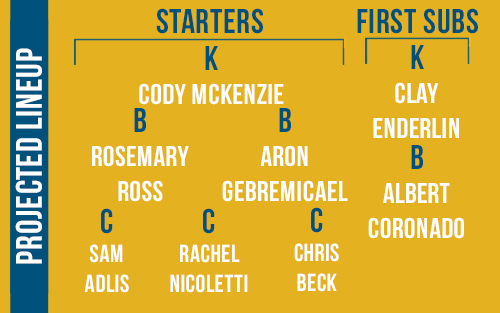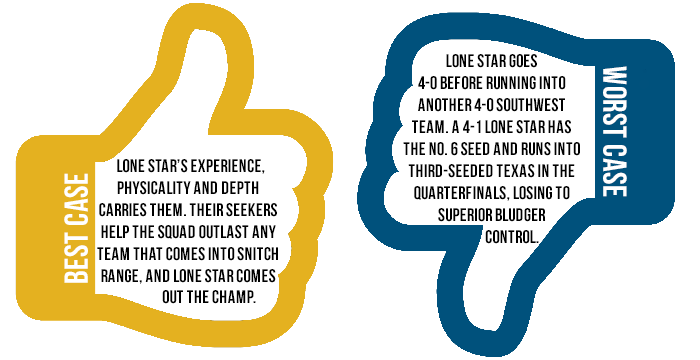- Rule, Britannia, no more?
- Unpopular Opinions: US Quadball Cup 2023
- Proven Contenders: University of Virginia
- Proven Contenders: Rutgers University
- Proven Contenders: University of Michigan
- Proven Contenders: Creighton University
- Different Perspectives: A Look Inside USA Ultimate
- Antwerp QC, Much of Belgian Core, Leaves Competitive Quidditch
Part XV
- Updated: March 4, 2015

Rock Hill Roll Call is your in-depth guide to the 80 teams that will compete for the title of World Cup 8 Champion. We’ve reached out to writers and analysts all over the country to bring you the lineups, strategies, focal points and aspirations of each and every attending team. Whether you are looking for a leg up on the competition or just want a detailed preview of the sport’s main event, this is the place for you.
 By Tad Walters
By Tad Walters
This season has been significantly different than the last three for Texas A&M University. This is the first year since World Cup V that most analysts do not view Texas A&M as a contender for the World Cup championship–some saying that under the new Swiss system, the team may not even make bracket play. However, with its new players and ever-growing team chemistry, has the quidditch community unrightfully written off this former Southwest powerhouse?
What makes Texas A&M a formidable team is its sheer athleticism. The squad has multiple players who can drive through entire defenses and score, and these same players can make bone-crunching hits on defense. Add in the coaching of veterans Sam Adlis, Rosemary Ross and non-player Casey Faulhaber, and this team is starting to look more and more like its old self at every tournament it attends.
Texas A&M’s passing game is overall smooth, with rough tosses and bad looks every few possessions. But when the offense is connecting, do not be surprised to see beautiful plays made from quick cuts to the hoops and crisp alley-oops threaded in between defenders. Watch out for plays on both sides of the ball from new keeper, Cody McKenzie, whose ability to swallow up passes or shots near the hoops frustrates opposing teams. Also crucial to the Aggie quaffle game are veterans Adlis and Clay Enderlin, who run the offense with patience–looking for passing options before attempting foolhardy drives against bludgers like some other members of the team will attempt to do.
In a World Cup format where athleticism truly matters, Texas A&M can and will shine by using just that.
 By Anonymous
By Anonymous
As the above author mentioned and, like many Southwest teams, Texas A&M is very athletic. However, like many mid-tier teams, it lacks a lot of game sense. The Aggies only know how to play one way, and their inability to adapt to other teams will be their downfall.
 Man defense has proven to be a Texas A&M strength this year and can be attributed to the team’s wins over University of Texas-San Antonio at Brooms on the Brazos and the University of Arkansas at the Southwest Regional Championship. Texas A&M’s height, speed and one-pass plays create mismatches that allow the Aggies to be successful against less-athletic man defenses. But where they really struggle is on offense against teams that run any kind of zone defense, as shown with losses to Loyola University-New Orleans and Osos De Muerte. The upper echelon of the Texas A&M squad will need to work with the rest of the team and increase its game IQ if it has any hopes of beating teams outside of the region–many of which run variations of a zone defense.
Man defense has proven to be a Texas A&M strength this year and can be attributed to the team’s wins over University of Texas-San Antonio at Brooms on the Brazos and the University of Arkansas at the Southwest Regional Championship. Texas A&M’s height, speed and one-pass plays create mismatches that allow the Aggies to be successful against less-athletic man defenses. But where they really struggle is on offense against teams that run any kind of zone defense, as shown with losses to Loyola University-New Orleans and Osos De Muerte. The upper echelon of the Texas A&M squad will need to work with the rest of the team and increase its game IQ if it has any hopes of beating teams outside of the region–many of which run variations of a zone defense.
Outside of Texas A&M’s inability to adapt to an opposition’s zone, the Aggie game lives or dies by their beaters. In multiple games this season, points were scored against Texas A&M solely because of beater errors such as the beaters pursuing a wing chaser instead of the quaffle, attempting long beats that missed or losing the team’s sole bludger on the other side of the field. Until the Southwest Regional Championship, every male beater was one-dimensional and fairly ineffective on both sides of the ball. However, Daniel Sobarzo has really stepped up and become easily the best beater on the team, using his cannon of an arm and speed to cover space effortlessly. The other beaters will have to get on Sobarzo’s level if they hope to have bludger control for a significant amount of time in their games.
 By We Breathe Quidditch
By We Breathe Quidditch
Nothing beats experience, and Lone Star Quidditch Club has perhaps the most experienced roster in the Southwest. Lone Star looked to be taking the path that Texas A&M University took last season, undefeated and untouchable, until suddenly at Alamo Cup, the squad suffered a loss to the University of Texas–the blemish on an otherwise perfect record. The gap between Texas and Lone Star closed, with one Eighth Man voter even choosing Texas as the No. 1 team in the nation.
Then came the Southwest Regional Championship, and Texas’s Alamo Cup performance became an anomaly. Baylor University beat Texas out of snitch range and Lone Star defeated both Baylor University and Texas State University far out of range as well.
It is incredibly hard to pinpoint one exceptional attribute of Lone Star, because it seems this team has it all. It is faster than the competition, but also more physical, more aggressive and more skilled than almost every team. Lone Star’s biggest obstacle this season has not really been an aspect of its gameplay, but rather a single opponent: Texas.
Even so, Lone Star can learn a lot from its struggles with the Longhorns. Lone Star thrives on its ability to score against a single-bludger defense. Against Eighth Man Top 10 opponents, Lone Star is 50-for-111 against one bludger–a scoring rate of 45.1%. Even more shocking is the fact that this average is skewed due to one or two bad performances–Lone Star against Texas State in the finals of Lone Star Cup scored a record-setting 83.3% of the time against a one-bludger Texas State defense.
Lone Star’s point of attack is simple: Boasting one of the most aggressive beaters in the Southwest with Sean Fry, Lone Star simply utilizes the 1.5 bludger technique on offense, taking out the sole defensive bludger and allowing Lone Star’s experienced and skilled chasers to take advantage of their opponents’ temporarily incapacitated beater.
Lone Star’s physicality can be proven by the fact that the team scores 100% of the time when facing a zero-bludger defense. Its chasing corps are leagues above the average chaser lineup.
If Lone Star doesn’t want to risk the chance of an upset by Texas, Texas State or Baylor in its journey to Rock Hill, the team will have to focus on its sole true weakness: obtaining and retaining bludger control and going up against a two-beater defense. Lone Star’s only loss this season came as a concerted effort by its opponents–the Longhorns’ chasers were dedicated enough to push Lone Star’s chasers to a side, lengthening the drive and giving their beaters more time to deal with Lone Star’s beaters and return to the game. Texas State played its closest game in four months against Lone Star solely due to the squad’s beaters’ ability to deal with Lone Star’s beaters quickly and effectively. The success of any team against Lone Star, therefore, will rest upon its ability to eliminate the offensive beater and maintain bludger control.
 By Anonymous
By Anonymous
It is difficult at best to look for individual weaknesses in Lone Star’s players. Defensively, Lone Star boasts probably the best keeper in the league in Stevie Bell. Bell likes to watch the eyes of the ball carrier and is very skilled at jumping in front of passes and creating a fast break opportunity for his team. Teams that tend to simply drive before dumping it off to the open chaser should try a different strategy.
Chasers Chris Scholz and Sam Haimowitz are extremely capable point defenders and are able to stop even the best drivers. Getting past the point defender requires handoffs and beater interaction.
 On offense, Lone Star simply uses its beaters to disrupt play enough to create a driving lane. However, if no driving lane exists, Lone Star will still attempt to get a pass to a female chaser behind the hoops. Chaser Becca DuPont is an incredible athlete and is nearly unstoppable behind the hoops. Keepers should always be ready to intercept the pass to DuPont.
On offense, Lone Star simply uses its beaters to disrupt play enough to create a driving lane. However, if no driving lane exists, Lone Star will still attempt to get a pass to a female chaser behind the hoops. Chaser Becca DuPont is an incredible athlete and is nearly unstoppable behind the hoops. Keepers should always be ready to intercept the pass to DuPont.
Female chaser depth falls off sharply after DuPont, so a strong defensive showing is important with her on the pitch. Lone Star has scored an average of 11 goals a game against Eighth Man Top 10 teams.
Perhaps the hardest aspect of Lone Star’s game to disrupt is the team’s seeking. Josh Tates is perhaps the most skilled rookie seeker in the entire sport this year. His enormous wingspan is a nightmare to snitches everywhere, so when defending against him and seeker Kifer Gregoire, bludger control is paramount. The only time Lone Star has not caught a snitch in a snitch-range game was when the team was going up against an opponent with bludger control–Gregoire completely occupied the snitch and Texas seeker Evan Carr saw the opportunity and took it.
Lone Star is without doubt the top team in the league, so every attempt to counter it must include controlling the pace of the game and careful strategy. Lone Star’s success at World Cup 8 hinges on how well it can play the game to its strengths.
Graphics and photo illustration by Amanda Dallas. Original photos by Monica Wheeler (NAU, Gambits) and Will Michels (Texas).




